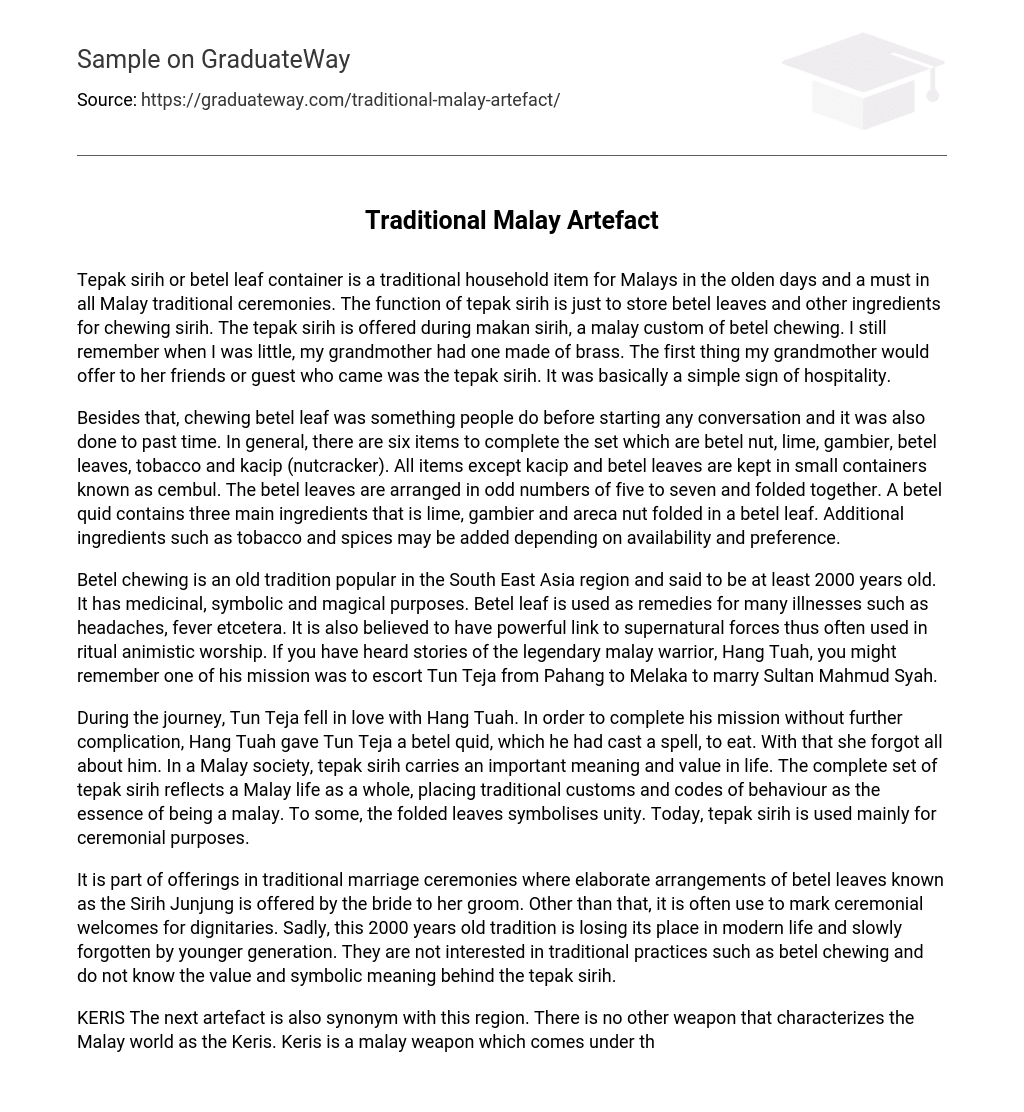Tepak sirih or betel leaf container is a traditional household item for Malays in the olden days and a must in all Malay traditional ceremonies. The function of tepak sirih is just to store betel leaves and other ingredients for chewing sirih. The tepak sirih is offered during makan sirih, a malay custom of betel chewing. I still remember when I was little, my grandmother had one made of brass. The first thing my grandmother would offer to her friends or guest who came was the tepak sirih. It was basically a simple sign of hospitality.
Besides that, chewing betel leaf was something people do before starting any conversation and it was also done to past time. In general, there are six items to complete the set which are betel nut, lime, gambier, betel leaves, tobacco and kacip (nutcracker). All items except kacip and betel leaves are kept in small containers known as cembul. The betel leaves are arranged in odd numbers of five to seven and folded together. A betel quid contains three main ingredients that is lime, gambier and areca nut folded in a betel leaf. Additional ingredients such as tobacco and spices may be added depending on availability and preference.
Betel chewing is an old tradition popular in the South East Asia region and said to be at least 2000 years old. It has medicinal, symbolic and magical purposes. Betel leaf is used as remedies for many illnesses such as headaches, fever etcetera. It is also believed to have powerful link to supernatural forces thus often used in ritual animistic worship. If you have heard stories of the legendary malay warrior, Hang Tuah, you might remember one of his mission was to escort Tun Teja from Pahang to Melaka to marry Sultan Mahmud Syah.
During the journey, Tun Teja fell in love with Hang Tuah. In order to complete his mission without further complication, Hang Tuah gave Tun Teja a betel quid, which he had cast a spell, to eat. With that she forgot all about him. In a Malay society, tepak sirih carries an important meaning and value in life. The complete set of tepak sirih reflects a Malay life as a whole, placing traditional customs and codes of behaviour as the essence of being a malay. To some, the folded leaves symbolises unity. Today, tepak sirih is used mainly for ceremonial purposes.
It is part of offerings in traditional marriage ceremonies where elaborate arrangements of betel leaves known as the Sirih Junjung is offered by the bride to her groom. Other than that, it is often use to mark ceremonial welcomes for dignitaries. Sadly, this 2000 years old tradition is losing its place in modern life and slowly forgotten by younger generation. They are not interested in traditional practices such as betel chewing and do not know the value and symbolic meaning behind the tepak sirih.
KERIS The next artefact is also synonym with this region. There is no other weapon that characterizes the Malay world as the Keris. Keris is a malay weapon which comes under the category of stabbing weapon. Experts say such weapons are only found in South East Asia. However, their form, name and function vary according to geographic location. In Aceh, it is called Rencong, South Sulawesi – badik, West Java – Kujang, Central and East Java as well as in Malaysia, it is known as keris.
The early function of Keris is as a weapon to defend oneself, to preserve one’s life, and as a close range weapon. However, as culture and social system develops, the function of Keris evolves. It changed according to the need and its contribution to human’s life where it started as a stabbing weapon, then became the object of reverence and respect as well as object of worship. In the olden days, Keris functions as symbol of service, rank or position. It is the symbol of power. Keris could also indicate the social status of the owner of the Keris.
The Keris is produce using the forging process where two different metals are hammered and folded together repeatedly until the blade took shape. Keris blades can be straight or sinuous. With sinuous blades, the bends are called luks. The number of luks in a keris should be odd, or the keris would be considered unlucky. Most Keris have either seven or nine luks with a minimum of one luk. Keris are of often considered to have an essence or presence, often associated with magical powers which as long as they do not contradict religion or certain ethical norm, are accepted by many.
It is believed that Keris acquired mystical and scientific properties during fabrication process. In the last century, the Keris, which has special significance for Malays, evolved from a royal weapon of choice to a status symbol in Malay history. Today the Keris are more for ceremonial and decorative purposes. It is part of the royal regalia during the King’s coronation and also carried by the Kings in certain ceremonies. It remains as a Malay Heritage.
References:
1. Prof. Dato’ Dr. Nik Hassan Shuhaimi Nik Abdul Rahman (ed.)(2006) The Encyclopaedia of Malaysia, Volume 4: Early History. Kuala Lumpur: Archipelago Press.
2.Encyclopedia Britannica Online. Encyclopedia Britannica Inc., 2012. http://www.britannica.com/EBchecked/topic/372953/megalith [09 Oct 2012]
3.Ismail Azman Omar (2009) Perkahwinan dan Kekeluargaan Raja-Raja Melayu dalam Sejarah Melayu. Karisma Publication Sdn. Bhd.
4.Dawn F. Rooney (1993) Betel Chewing Traditions in South East Asia. Kuala Lumpur: Oxford University Press.





